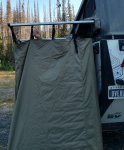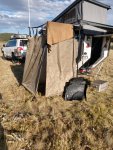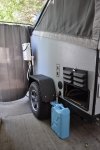This is an older thread, but I know
@JimboT you are looking at multi-months on the road from one of your other threads, so I'm guessing you are actively researching showers and so I'll share my experience. We've used a few systems. The "best" system will very much depend on individual needs, but for what it's worth:
1) We've used the Zodi system with a gas burner and battery water pump for years. Loved it and no complaints other than the water pressure was a bit disappointing, but there's only so much PSI a few D-cell batteries can create and it was very economical on water. It packed into a tiny case about the size of an ammo tin, which made it super easy to carry for the person who stole it from us, which brought us to our next system...
2) An eccotemp. This is a great little propane gas water heater, but it's not perfect. For starters, it's big. Ours is mounted in a pelican case for portability, and the case is about 30 inches by 20 inches by 10 inches deep. It also does not have it's own pump, so you need running water for it to work. We mounted a 12V RV pump on a pressure switch that the Eccotemp can hook up to. This gives us plenty of power and pressure but it also has an auto-shutoff so water use is VERY economical. I can't say how much water we use just for showering, but we generally fill a 5 gallon pail from the nearest water source with a dunk (so at most 2/3rds full) and we've had 4 people shower without running out of water in the bucket.
3) Our next system will again include the on-board pump. Having a 12v water pump on longer trips is super handy for more than just cleanliness. It can be used to hose stuff down, draw water from a creek into a container, push water through a filter, etc. and for the relatively small space of a couple of fittings and the pump, it's a very weight- and space- economical upgrade. For heat, we'll either be going with an under-hood heat exchanger, or going ultra simple and just heating water over a stove or fire, and then pumping from the lukewarm water bucket. Depending on our 12V setup, we would also consider an electric water boiler; Andrew St. Pierre White has installed one in his "Aussie Dream Tourer" build and I'm following that option to see how it works out.
On longer trips some kind of plan for personal hygiene is important -- to me, it's actually a safety issue, so whatever system we go with will have to be super easy to use so that a shower is just a normal and easy thing to just do. If there's too much setup or messing about, it will deter the user from showering, and thus introduce a safety risk. What the heck am I talking about showers being a safety item?
Well, for our domestic trips we are often in tick territory, and a shower gives you a really good opportunity to check for those little jerks before you get crippled by Lyme disease. Time is of the essence with a tick bite, so regular showers equal regular tick checks. I've seen hikers check for ticks at trailheads, but modesty usually prevents folks from checking the places where ticks like it best. In a shower, those places SHOULD get covered with soap, so you'll know right away if you have a hitch hiker!
Secondly, your skin is the largest organ in your body, and if it's compromised, you're going to have a bad time. If you are in good shape and conditioned to hike and adventure this is less of a concern, but if you are like many of us who spend most of our time in air conditioned offices, your skin won't be used to hard work and sweating and how all that interacts -- even while sitting still in a seat day after day. Sweat residue leaves behind tiny mineral deposits, and eventually that and the moisture equals chafing. Chafing -- even minor chafing, like around a seam in your underpants or where your seatbelt sits on your chest or neck -- is miserable, and can lead to infection quick if one isn't careful. A regular cleaning can remove some of these tiny mineral deposits and reduce the risk of chafing dramatically.
Thirdly, it's a huge safety hazard to climb into a 2-person tent after a few days of activity without a shower. That's how people "go missing" on these trips and their significant other swears up and down they just wandered off one night

(That last one is tongue in cheek, but it's still nice to your travel companions to not stink).




